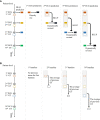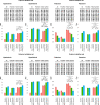Development and validation of a dynamic deep learning algorithm using electrocardiogram to predict dyskalaemias in patients with multiple visits
- PMID: 36743876
- PMCID: PMC9890087
- DOI: 10.1093/ehjdh/ztac072
Development and validation of a dynamic deep learning algorithm using electrocardiogram to predict dyskalaemias in patients with multiple visits
Abstract
Aims: Deep learning models (DLMs) have shown superiority in electrocardiogram (ECG) analysis and have been applied to diagnose dyskalaemias. However, no study has explored the performance of DLM-enabled ECG in continuous follow-up scenarios. Therefore, we proposed a dynamic revision of DLM-enabled ECG to use personal pre-annotated ECGs to enhance the accuracy in patients with multiple visits.
Methods and results: We retrospectively collected 168 450 ECGs with corresponding serum potassium (K+) levels from 103 091 patients as development samples. In the internal/external validation sets, the numbers of ECGs with corresponding K+ were 37 246/47 604 from 13 555/20 058 patients. Our dynamic revision method showed better performance than the traditional direct prediction for diagnosing hypokalaemia [area under the receiver operating characteristic curve (AUC) = 0.730/0.720-0.788/0.778] and hyperkalaemia (AUC = 0.884/0.888-0.915/0.908) in patients with multiple visits.
Conclusion: Our method has shown a distinguishable improvement in DLMs for diagnosing dyskalaemias in patients with multiple visits, and we also proved its application in ejection fraction prediction, which could further improve daily clinical practice.
Keywords: Best linear unbiased prediction; Deep learning model; Ejection fraction; Electrocardiogram; Linear mixed model; Potassium.
© The Author(s) 2022. Published by Oxford University Press on behalf of the European Society of Cardiology.
Conflict of interest statement
Conflict of interest: None declared.
Figures





Similar articles
-
Extensive deep learning model to enhance electrocardiogram application via latent cardiovascular feature extraction from identity identification.Comput Methods Programs Biomed. 2023 Apr;231:107359. doi: 10.1016/j.cmpb.2023.107359. Epub 2023 Jan 20. Comput Methods Programs Biomed. 2023. PMID: 36738606
-
Artificial Intelligence-Enabled Electrocardiogram Predicted Left Ventricle Diameter as an Independent Risk Factor of Long-Term Cardiovascular Outcome in Patients With Normal Ejection Fraction.Front Med (Lausanne). 2022 Apr 11;9:870523. doi: 10.3389/fmed.2022.870523. eCollection 2022. Front Med (Lausanne). 2022. PMID: 35479951 Free PMC article.
-
Electrocardiographic biomarker based on machine learning for detecting overt hyperthyroidism.Eur Heart J Digit Health. 2022 Apr 20;3(2):255-264. doi: 10.1093/ehjdh/ztac013. eCollection 2022 Jun. Eur Heart J Digit Health. 2022. PMID: 36713007 Free PMC article.
-
Development and validation of a deep learning model to screen hypokalemia from electrocardiogram in emergency patients.Chin Med J (Engl). 2021 Sep 2;134(19):2333-2339. doi: 10.1097/CM9.0000000000001650. Chin Med J (Engl). 2021. PMID: 34483253 Free PMC article.
-
A Deep Learning Algorithm for Detecting Acute Pericarditis by Electrocardiogram.J Pers Med. 2022 Jul 15;12(7):1150. doi: 10.3390/jpm12071150. J Pers Med. 2022. PMID: 35887647 Free PMC article.
Cited by
-
Development of deep learning algorithm for detecting dyskalemia based on electrocardiogram.Sci Rep. 2024 Oct 1;14(1):22868. doi: 10.1038/s41598-024-71562-5. Sci Rep. 2024. PMID: 39353972 Free PMC article.
-
Current and Future Use of Artificial Intelligence in Electrocardiography.J Cardiovasc Dev Dis. 2023 Apr 17;10(4):175. doi: 10.3390/jcdd10040175. J Cardiovasc Dev Dis. 2023. PMID: 37103054 Free PMC article. Review.
References
-
- Stout KK, Daniels CJ, Aboulhosn JA, Bozkurt B, Broberg CS, Colman JM, Crumb SR, Dearani JA, Fuller S, Gurvitz M, Khairy P, Landzberg MJ, Saidi A, Valente AM, Van Hare GF.. 2018 AHA/ACC guideline for the management of adults with congenital heart disease: executive summary: a report of the American College of Cardiology/American Heart Association task force on clinical practice guidelines. Circulation 2019;139:e637–e697. - PubMed
-
- Raghunath S, Ulloa Cerna AE, Jing L, vanMaanen DP, Stough J, Hartzel DN, Leader JB, Kirchner HL, Stumpe MC, Hafez A, Nemani A, Carbonati T, Johnson KW, Young K, Good CW, Pfeifer JM, Patel AA, Delisle BP, Alsaid A, Beer D, Haggerty CM, Fornwalt BK. Prediction of mortality from 12-lead electrocardiogram voltage data using a deep neural network. Nat Med 2020;26:886–891. - PubMed
LinkOut - more resources
Full Text Sources
